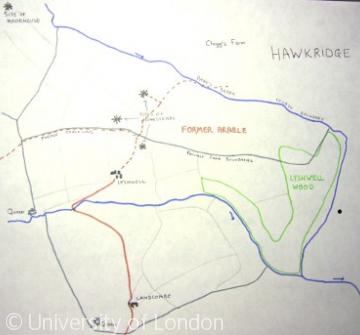Lyshwell shrunken settlement

Sketch map of Lyshwell, a shrunken settlement in Molland parish, Devon as it was in 1880s.
Lyshwell in Molland was a hamlet but now only one farm survives. Close to Lyshwell farm are three deserted sites very close. Slightly further away are two more deserted sites, one called Morehouse, which was in existence in the 17th century and abandoned by the 19th century, the other and perhaps more interesting is Landcombe, a 19th-century farm abandoned in the early 20th century after a life of about 60 -70 years.
Lyshwell was known as Lishall until the late 19th century, and earlier as Lysteshele. A piece of land near Lyshwell on the edge of Molland Common was described in 1496 as bordland. By the mid 16th century Lyshwell was divided into North and South farms, the latter name persisted until the late 19th century for the present Lyshwell farm. It is probable that there were only two farms at Lyshwell and that the other two sites were cottages. In 1693 William Hensley of Hawkridge, worsted comber, leased a cottage on Molland moor, probably Lyshwell, with a garden and hopyard and in 1707 a carpenter from West Anstey leased a house and land at North Lyshwell, on which to build a house. The farm at North Lyshwell belonged to the Chichester family of Arlington who also owned farms called Adlehole and Mousehole in Molland in 1733. In 1763 John Chichester and his wife Alice leased North Lyshwell to John Pine of East Devon for 99 years or lives. This farm, which had a courtyard farmstead appears to have been abandoned in early 19th century and the other two house sites had also been abandoned by 1840.
Content generated during research for the paperback book 'Exmoor: The making of an English Upland' (ISBN 13 : 978-1-86077-597-0 ) for the England's Past for Everyone series







